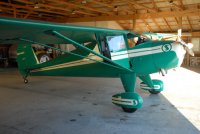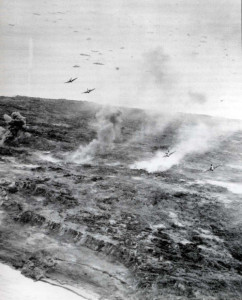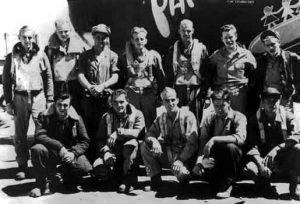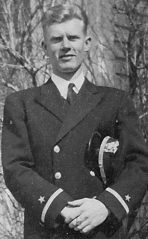Henrik Walter Strombotne
Dad’s brother, Chris, took up flying in Cheyenne, Wyoming and in fact made the local newspaper there when his Luscombe trainer lost a wheel (leaving only one) to make a safe emergency landing return. Chris later flew for the Canadian Royal Air Force where he received the bulk of his experience. When hostilities broke out and the USA went to war, Chris endeavoured to come back to the United States and do his part. He received an ‘advanced commission’ with the US NAVY as an Ensign meaning; he was not required to test-in or go through Basic but was accepted based on his already credible experience as an instructor pilot.
1942
Chris was instrumental in getting his brothers Henrik and Norman to enlist early on, saying to them, “you’ll end up a foot soldier if you wait“. He encouraged Dad to visit a recruitment pre-screen at the University Wyoming located in Laramie. He was inducted into the Civilian Pilot Training program (CPT) at Brees Field that September. Pilot trainees usually were required to solo after 11 hours of Dual instruction in the 65 h.p. Luscombe trainer. Dad achieved his 1st Solo flight after 8.2 hours and in 3 months time, completed his CPT with a checkride 8 November. His CPT Pilot Rating Book lists 28.2 hours of dual and 15 solo hours for a total of 43.2 TT.
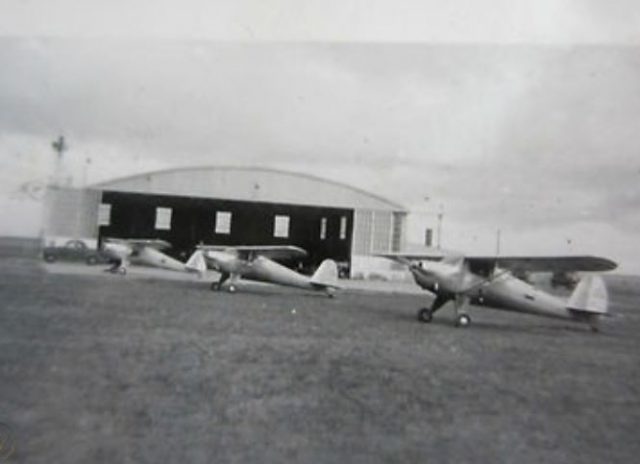
1943
Dad reported to Navy Pre-flight School on the University of Iowa campus in Iowa City on January 21, 1943. Communications, theory of flight, gunnery, celestial navigation, aerology, aircraft recognition, engines and Naval history and traditions, with particular attention to Naval regulations. Physical training – calisthenics, swimming, basketball, soccer, football, gymnastics, wrestling, boxing, volleyball and hand-to-hand combat – was stressed throughout the training program. The pre-flight program was of 11 weeks duration.
“I wanted to join the Navy as an officer. My vision was 20-15” (exceptional) “…but the eye exam for color gave me trouble.” (a potential disqualification) He got hold of the Ishihara color charts used for testing and, “I memorized the chart!”. Dad loved athletics. He was in great physical shape having established a work ethic back home in Wyoming. Dad could handle a Fresno Plow behind a 4 horse team in a local gravel quarry. Having grown up in a competitive sense with his two brothers Chris and Norman, Dad was tops in Boxing and Wrestling among his Naval Cadets peers. “I was undefeated” save for an injury sustained when sparing with a fellow “bigger than I was and my leg got bent the wrong way. My knee was never the same again and even though while healing on crutches for a period of time, I was able to complete the routine… [for example] swimming the length of an Olympic sized pool underwater with one leg [trailing]. The rule was that in order to graduate, you had to stay with your class.”
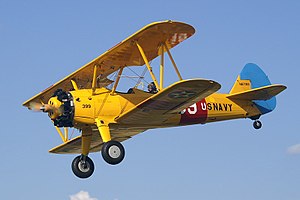
Primary flight training for Cadets commenced at the Hutchinson Naval Air Station near Wichita with initial air work in Boeing Stearman N2S 3 bi-planes; known colloquially as the “Yellow Peril” from its overall-yellow paint scheme. Next came a checkout in the fixed gear but slightly more complex Vultee SNV-1 for the second phase of the training program.
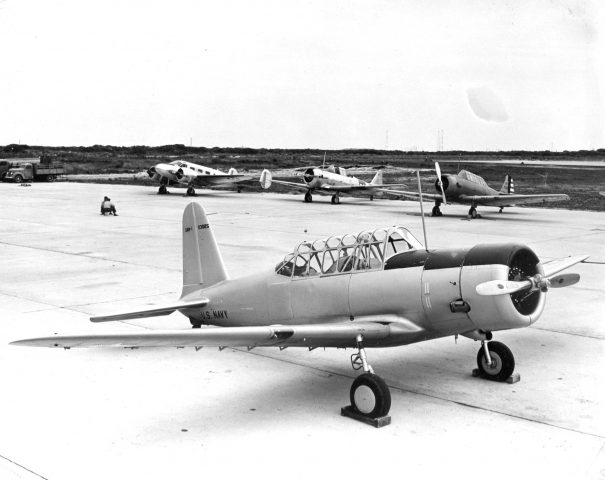
“Vultee Vibrator.”
Successful candidates were transferred to a Texas air base in Corpus Christi where they practiced more advanced flying such as acrobatics in even more powerful aircraft. Other aircraft flown:
Naval Aircraft Factory N3N-3
North American SNJ-4

1944
Advanced training continued at the NAS Jacksonville (Cecil Field/Green Cove Springs) in Florida where they were introduced to the Douglas SBD -4 / -5 Dauntless, a scout plane and dive bomber. but it was the Grumman F6F Hellcat single-seat fighter / fighter-bomber aircraft, powered by a 2,000 hp Pratt & Whitney R-2800-10 Double Wasp radial that Dad would eventually fly on war missions and in battle combat. The base in Jacksonville simulated an aircraft carrier’s very short landing surface with overlay markings painted on the tarmac. It was the sawed off tree stumps no-mans land on the approach and departure overruns which “kept you honest”.
February: NAS Alameda (California)
His first training first flight in the F6F-3 was mid April after arriving at NAS Pasco Washington (Bombing Squadron 9) Other aircraft flown: FM-2 essentially a late production variant of the F4F Wildcat design but built by General Motors and Eastern Aircraft
September: “We progressed to San Ysidro’s Ream Field [Southern California] for the final phase of training “We also practiced on a landing surface actually floated on a special vessel made by Kaiser. We were required to make 3 consecutive (successful) landings” during final flight test evaluations. From the cockpit on an approach this area appeared impossibly small. A carrier used arresting cable gear to snag landing planes. On one of these practice ships, a new pilot botched his landing and crashed on the training carrier field, killing himself. “The rest of us that day were ordered to climb to 10,000 feet and circle in the area to wait for the wreckage to be cleared off.” The perspective view from that height exaggerated and seemed to multiply our doubts and undermine self confidence. That field was postage stamp size and it was do or die since at that stage of training the practice area was well off shore and thus beyond the fuel range for anyone to have thoughts of returning to the California coastline. Carrier Qualification was completed on September 13th in an F6F-5 using CVE-94 [escort class] USS Lunga Point
With ground and flight school complete we were sent from San Francisco to the Pacific theater via Pan American World Airways Martin Flying Boat with stops in Pearl Harbor, Hawaii, Guam, and finally Ulithi Atoll where we were assigned to the USS Yorktown CV-10. Dad recalls being cheated out of a birthday. By coincidental timing, “we crossed the International Date Line on the night before and lost a day.” Dad was 21 years old. (plus one)
Detached from the task force on 23 November Yorktown arrived back in Ulithi (staging anchorage) on 24 November. Dad joined his ship then (30 November)
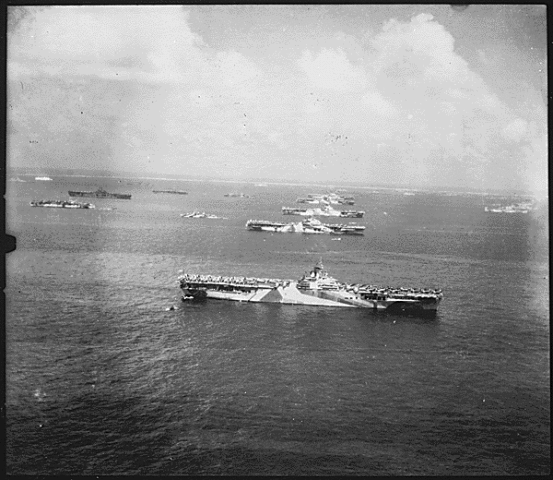
“I was astonished to be in tropical waters. It was so warm. Growing up in Wyoming, I’d never experienced such wonder.” Otherwise there were few escapes from oppressive heat and humidity in the South Pacific. They were allowed the occasional swim which was followed by salt water showers. Sleeping below deck was near to impossible due to lack of refrigeration in those days. “I would come topside for air.” The artificial breeze from the ships forward movement offered relief. A carrier’s flat top upper deck also offered expansive space for exercise and calisthenics. “The vessel’s pitching made pushups very hard as you tried to extend your arms against it’s rise and fall.” There was an ice cream making machine onboard and “we ate extremely well – steak when you wanted.”
10 December, Yorktown put to sea again to rejoin Task Force 38. She rendezvoused with the other carriers on 13 December and began launching airstrikes on targets on the island of Luzon [Manilla] in preparation for the invasion of that island scheduled for the second week in January.
On 17 December, the task force began its retirement from the Luzon strikes. During that retirement, TF 38 steamed through the center of the famous typhoon of December 1944. He and another plane were among the last permitted to land aboard ship during the hurricane. The carrier deck was pitching so radically that there could be no more landing operations — for risk of damaging the ship. This meant that a small unfortunate remainder flew until fuel exhaustion and then went into the rough sea. Those were never heard from again.
The confused ocean had dramatic effect even on as large a ship as the Yorktown. The stern would rise and the propellers would cavitate “shaking the whole ship. The bow would dip down in a trough and the waves appeared higher than the flight deck – – 150 feet!”. That storm capsized and sank three destroyers—Spence, Hull, and Monaghan — and Yorktown participated in some of the rescue operations for the lone survivors of those three foundering ships.
The warship arrived back in Ulithi on 24 December. Yorktown fueled and provisioned at Ulithi until 30 December at which time she returned to sea to join TF 38 on strikes at targets in Formosa and the Philippines in support of the landings at Lingayen.
View Map Track of the Yorktown and Task Group 38 in the South Pacific from December 1944 until the end of Dad’s tour of duty – March 1945
It would seem that the more dangerous aspect or closest call would be during training or even routine logistics of fuel management and navigation. Getting lost and then running out of gas meant ditching into the sea where you might or might not be found and picked up before enemy or sharks got you. “They gave us ‘shark repellent‘ but I figured that this was more of a morale booster then effective. In flight school they told us to ALWAYS TRUST your flight instruments.” He would witness this at least once when experiencing disorienting vertigo while in cloud. “I was flying by the seat of my pants and you couldn’t see blue sky or ground for reference but, I glanced at my instruments and noticed that my airspeed was high and altimeter unwinding.” Luckily he came to the (correct) conclusion that he was headed for disaster and arrested the descent and resumed climb. He and his wingman had become lost. They had been assigned to fly vectors issued over radio by a radar controller aboard a fleet destroyer. The controller would scan his scope for Bogeys, which could be potential Kamikaze, and then would dispatch the pair to intercept. After many heading changes Dad’s flight of two lost awareness of their precise position having been relying on their controller for guidance. But the radio controller soon lost touch with them as he vectored them to and fro – beyond transmitter signal coverage. With the need for self help they decided to try and get above the clouds to get their bearings. Out of ideas, his “wingman made visual signal motions to me that ‘you’ve got it’. I took the lead and from on top we were keen to hear the single navigation beacon from our carrier that would return us home. We were really low on fuel by now flying box patterns to try and pick up that signal. Straining for that familiar morse code signal we finally located our ship. Not wanting to approach from such a high altitude and be mistaken for enemy ourselves we descended promptly to just above sea level and by miracle our carrier was steering into the wind and receiving the last arrivals. My wingman and I just joined the landing pattern and safely arrived as though nothing had ever happened. We were lucky.” If a carrier perceived danger or suspended landing operations stragglers where asked to ditch alongside and they would be picked up (hopefully).
1945
“We saw airborne action raids over Iwo Jima, Okinawa, and over Formosan airfields where we shot our rockets at enemy aircraft as they sat imobile on the ground and encountered some of the fiercest defense in the form of return fire. The sky blackened with flak and tracers seemed to came right at us. It was the bullets that I COULDN’T see that I thought about.”
The carriers began with raids on airfields on 3 January on the island of Formosa and continued with various targets for the next week. On 10 January, Yorktown and the rest of TF 38 entered the South China Sea via Bashi Channel to begin a series of raids on Japan’s inner defenses. On 12 January, her planes visited the vicinity of Saigon and Tourane Bay, Indochina, in hopes of catching major units of the Japanese fleet. Though foiled in their primary desire, TF 38 aviators still managed to rack up a stupendous score—44 enemy ships, of which 15 were combatants. On 15 January raids were launched on Formosa and Canton in China. The following day, her aviators struck at Canton again also went to Hong Kong. “We came upon a solitary boat” west of Formosa which he described as a ‘chinese junk ‘ This heavy timbered vessel seem to absorb any damage from their 50 caliber machine guns by refusing to sink as he and his buddies (8 planes) made numerous strafing runs upon it. “I didn’t know if there was anyone on it but felt sorry for them if there were.” You might think this the cat toying with the mouse but the enemy was resourceful and used any and everything to try and take us out. As an example, the derelict hull of a vessel previously out of commission and half sunk in shallow water turned up with impromptu anti-aircraft gun emplacements one day. This the flyers realized when startled to see enemy tracer fire emanate from the wrecked hulk and spent “rounds striking the sea just shy of my position.”
On 20 January Yorktown exited the South China Sea with TF 38 via Balintang Channel. She participated in a raid on Formosa on 21 January and another on Okinawa on 22 January before clearing the area for Ulithi.
“We’d generally fly low on the water, to avoid enemy detection. When an island appeared, we would climb slightly so as to just pop over and clear the obstacle. On one such hop after a bombing run, I found myself directly overhead an enemy gun emplacement. Quite a nest of guns actually; and it was a little hair raising to be staring down barrels of these cannon as I saw the enemy ground crew struggle to swing to and get a bead on me. But my sudden appearance had surprised them as much as it had surprised me. I was the first to fire a burst from my 50 caliber machine guns as I passed and lucky for me I saw them briefly cower which delayed their retaliation and they never got off a shot in time. I’d have been blown to bits otherwise.”
On the morning of 26 January, Yorktown re-entered Ulithi lagoon with TF 38. She remained at Ulithi arming, provisioning, and conducting upkeep until 10 February. At that time, she sortied with TF 58, the 3rd Fleet becoming the 5th Fleet when Spruance relieved Halsey, on a series of raids on the Japanese and thence to support the assault on and occupation of Iwo Jima.
An advantage for the military pilot was that he never really saw the enemy eye to eye. “We carried a single 500lb bomb or a Napalm bomb, and 6 rockets distributed 3 on each wing. We were given flight missions to carry out and we did them. Some guys were afraid and would abort and return and or not even launch feigning perceived engine or mechanical trouble.” Dad was proud to report that during the length of his tour that he “flew more missions than anyone in his air group except for one other guy.”
On the morning of 16 February, the carrier began launching strikes on the Tokyo area of Honshu. On 17 February, she repeated those strikes before heading toward the Bonins. Her aviators bombed and strafed installations on Chichi Jima on 18 February. The landings on Iwo Jima went forward on 19 February, and Yorktown aircraft began support missions over the island on 20 February. Those missions continued until 23 February at which time Yorktown cleared the Bonins to resume strikes on Japan proper. She arrived at the launch point on 25 February and sent two raids aloft to bomb and strafe airfields in the vicinity of Tokyo.
Dad’s Air Group #3 was one of the first wave of US planes to go over mainland Japan. It was here that Dad engaged in air to air fighting (only once) he and a wingman were on the receiving end of a dogfight with a Japanese Zero [the Mitsubishi Zero’s had extraordinary maneuverability] . They both tried climbing at full power while trying to pursue. “We were ‘hanging on the prop’ (near stall speed) but the Zero was lighter and always still right there just above our gun sights at which point he kicked his rudder and came back down at us.” The Japanese pilot had a shot and “hit my wingman, who went down. When I returned to the Yorktown I learned that my wingman had landed in the sea and was picked up.”
On 26 February, Yorktown air crewmen conducted a single sweep of installations on Kyushu before TG 58.4 began its retirement to Ulithi. Yorktown re-entered the anchorage at Ulithi on 1 March. She remained in the anchorage for about two weeks. At this point Dad’s tour came to a close. His flight log book entry on the 9th of March 1945 states ‘Going home’
He and other veterans left his ship for the United States via the USS Lexington CV-16 (bound for a Puget Sound overhaul). On the 10 day return journey they visited Guam “with orders to stay out of the jungle because of enemy hold outs” keen on perpetuating the war. By policy, naval pilots served in combat for a finite tour (e.g. 250 combat hours, or six months, or 25 missions whichever came first). Then they rotated home, typically to train other pilots.
He was assigned to VBF-97 air squadron at NAS Gross Ile (Michigan) that spring continuing to fly VF aircraft including the Vought F4U-1D Corsair and then was detached to the Naval Photographic Reconnaissance Training School (Squadron Two) at the Naval Air Facility in New Cumberland (Harrisburg, PA) . Through the summer Dad became qualified for combat photography and photographic intelligence with the F6F-3P, a photo reconnaissance conversion with one camera in the rear fuselage just behind the wing.
In September he traveled back to the West Coast reassigned by CASU-50 [NAS Seattle] to Pasco Washington to await the reforming of Fighting Squadron 12.
October: Reim Field [San Diego] Other aircraft flown there: Beechcraft Staggerwing GB-2, and the NE-1 — the Navy version of the civilian Piper ‘Cub’. In fact, according to the logbook, Mom! was Dad’s passenger in NE-1 [49340] on a joy flight from the Burbank airport on November 4th.

Dad’s last F6F-5 flight logged was a 2.0 hr search mission across the border into Mexico on December 28, 1945. Final flight made (TBM cross-country) was on January 7, 1946. He’d logged 793.5 naval flying hours for a grand total of 836.7 TT with 48 actual carrier landings.
Decoration Medals and Awards:
- Air Medal
- American Area
- Asiatic-Pacific Area ( 2 Stars )
- Philippine Liberation ( 1 Star )
- World War II Victory

(“Felix the Cat” )
Reconstructed Route Trace of the USS Yorktown during Dad’s Tour

Norman Strombotne
Brother Norman’s plane, badly shot up [Flak], went down in Austria. They had to bail out because of mountainous terrain; a landing was not possible. Norman said that they “parachuted into a massive snow bank and that by the time they had extricated themselves enemy soldiers were there to greet them — rifles pointed”. He was interned for the duration in a German POW camp. Stalag Luft I in Barth, Germany. North 3 – Barracks 9 (Block 309) Room 6. There is a reconstructed narrative based on Lt. John E Thompson’s P.O.W. diary. He details his journey to the internment camp, time spent there and Uncle Norman’s was likely carbon copy.
Following advanced Navigational training at ANS San Marcus, Texas, Uncle Norman was assigned to the 415th Squadron operating the Consolidated B-24 Liberator. He flew combat missions from Lecce Airfield, Italy as part of the 98th Bombardment Group. Uncle Norman flew in a number of sorties, which are listed. Most of these records were methodically type written documentation. The period Nov 12 to Dec 21 however is vague. Those narratives do not list the crews and they were not transcribed.
- Nov 5 Vienna Florisdorf Oil Ref., Austria
- Nov 7 1944 Mezzacorona RR Bridge, Italy
- Nov 8 1944 Vienna/Schwechat Oil Refinery, Austria
- Nov 12 1944 Avisio Viaduct, Italy
- Dec 21 1944 Rosenheim Marshalling Yards, Germany
- Dec 29 1944 Brenner Pass Rail Loop, Italy
Brenner Pass is a mountain pass through the Alps along the border between Italy and Austria, and is one of the principal passes of the Alps. It is the lowest of the Alpine passes, and one of the strategic importance in the area. The 29 December 1944 mission, was his last as they were shot down this date. The best we can piece together is that the aircraft suffered damage from Flak after having reached the heavily defended target. Hearsay info puts the aircraft shot down near Vipiteno (Fundres (Pfunders) in the Italian province of South Tyrol (Süditrol)) just below the Austrian border.
picture credit: 680 Paper Doll
15th Air Force / 98th Bomb Group / 415th Bomb Squadron [ link ] The black/yellow stripes for the 98th BG is their tail code marking. The RCL (recall code) was “B” painted in red.
2nd Lt. Norman J. Strombotne was recognized for his participation in the Northern Apennines Campaign. He was awarded:
- European-African-Middle East Eastern Ribbon with 3 Battle Stars
- Air Medal with one Oak Leaf Cluster
- Overseas Service Bar
- Purple Heart
Christopher E Strombotne
Brother Chris, while stationed at Los Alamitos training, field lost his life (1943) in an accident stateside. He and his student in one aircraft touched wings or otherwise collided with a similar aircraft during a flight formation training exercise.
